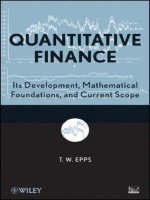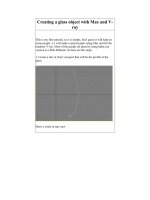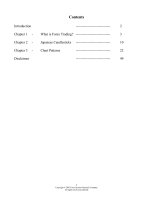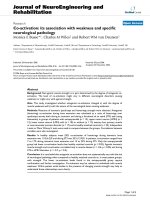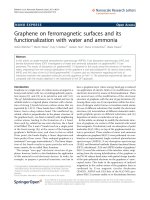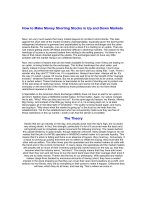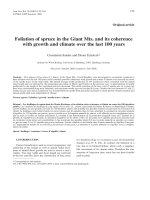Money its connexion with rising and falling prices
Bạn đang xem bản rút gọn của tài liệu. Xem và tải ngay bản đầy đủ của tài liệu tại đây (8.38 MB, 138 trang )
MONEY:
ITS CONNEXION WITH RISING AND
FALLING PRICES
BY
EDWIN CANNAN
Emeritus Professor of Political.Economy in the University
of London
SEVENTH EDITION
WESTMINSTER
P. S. KING & SON, LTD.
ORCHARD HOUSE, 14 GREAT SMITH STREET, S.W.I
1932
Fi,st Published
2nd Edition
3,d
4th
5th
(cloth)
1918
1920
1921
1923
1926
6~
1~9
7th
193 2
PRINTED IN GREAT BRITAIN
PREFACE TO THE SEVENTH
EDITION
IN this edition I have added, as Appendix III, a brief
account of the abandonment of the gold standard
by England in 1931 and an estimate of its consequences. Otherwise the book is unaltered except
that I have made in Appendix II some small changes
necessitated by the present having become the past.
July
I,
1932.
v
PREFACE TO THE SIXTH
EDITION
THE first edition of this book was written in August
and September, 1918, before I knew that the war
was at last coming to an end, and it was published
soon after the Armistice.
In this country the evil of over-issue of currency
had not progressed nearly so far as in several others,
and in the light of the subsequent experience of
Russia, Germany, and Poland the British note issue
of that time looks quite trifling; converted into
marks at the pre-war rate of twenty to the pound
the whole amount outstanding was then only a
trifling fraction of the number of marks which were
added each day to the German currency in the autumn
of 1923. But in the eye of the prophet a little cloud
no bigger than a man's hand may be the herald of
a storm, and the situation was made specially alarming by the amazing delusions which prevailed even
in most expert " quarters about the paper pounds
which, though the supersession of gold coin had
long ago been practically completed, had been paid
out by the Treasury during the previous twelve
months at an average rate of over a quarter of a
million pounds a day, including Sundays. Government apologists, among whom were not only officials,
vi
II
PREFACE
vii
but many journalists and even a few economists,
actually contended that the CWTency Note issue
made under a purely permissive Act of Parliament,
.was uncontrollable by any authority or human
being, or at the least that it could not be checked
without making' the Bank of England bankrupt.
cc People constantly speak," said one of them, cc as
though the issue of currency notes were somehow
within the power of the Treasury to regulate. But
surely this is not so. Anyone who has a balance at
the Bank of England can turn it into cWTency notes
ad lib. How is he to be stopped?" The Bank was "
supposed to have an incurable diarrhrea of pounds,
though she had never suffered from that disease
before the laxative of the CWTency and Bank Notes ;'
Act, I9I4, was administered to her.
The House of Commons Select Committee on
National Expenditure, after hearing the Treasury
on the subject, declared in its Second Report, cc Notes
are not issued in order to make Government payments," without making the slightest attempt to
explain how the Government managed to get rid of
the proceeds of the issue without paying them away.
All this made me think it desirable to add to my
Wealth a chapter containing the elementary principles
on which the value or purchasing power of money
depends, but the exposition turned out longer than
I expected, so that it seemed 'better to publish it
separately. This, unaltered e~ept for a few unimportant corrections and some excisions or amendments of allusions to states of things no longer existing, forms Part I of the present edition.
viii
PREFACE
Part II, sections 1-4, and Part III, sections I and 2,
were added in the fourth edition, 1923, taking the
place of two sections dealing with the rise of prices
in 1914-20 which had appeared in the second and
third editions. Much of sections I and 2 of Part II
were taken, by kind permission of the editors, from
a paper read to. the Economic Section of the British
Association at Edinburgh, which was printed in the
Economic Journal for December, 1921.
Section 5 of Part II, section 3 of Part III, and
the two Appendices, were added in the fifth edition,
1926 .
In the present edition I have continued Appendix
II, explaining the changes which have been made in
the gold standard, so as to make it cover the effect
of the Currency and Bank Notes Act, 1928, which,
ten years and eleven days after the Armistice of
November 11,1918, put an end to the Currency Note
Issue hastily conceived as an emergency currency
in the hectic days of August, 1914.
January, 1929.
I
CONTENTS
PART I.
GENERAL PRINCIPLES
PA02
§ I. INTRODUCTION
§ 2.
RECOGNITION
1-2
AND
MEASUREMENT
OF
CHANGES IN THE VALUE OF MONEY
A change in general prices is the same thing as a
change in the value of money
Which is difficult to recognize and is often denied
But can be measured by means of index numbers
2-8
2-3
3-4
4-8
§ 3. THE VALUE OF MONEY OR GENERAL LEVEL
OF PRICES WHERE THE UNIT OF ACCOUNT
IS A FIXED QUANTITY OF BULLION UN-
8-25
COINED OR COINED
Free interchangeability of bullion and coin makes
their value identical
The value of gold depends on the demand for industrial and currency purposes .
.
And on the supply
.
It is affected by anticipation of future changes
8-10
10-19
19-21
~n-s
§ 4. THE VALUE OF MONEY OR GENERAL LEVEL
OF PRICES WHERE THE UNIT OF ACCOUNT
IS A COIN OF WHICH THE ISSUE IS LIMITED
25-39
A seignorage keeps the value of coin above that of
bullion by limiting its supply.
25-9
Similarly an arbitrary limitation of supply can be
worked so as to keep the value of a coin at any particular
level above that of bullion
. 29-30
Like the British silver coins
30-6
And the Indian rupee
36-9
ix
CONTENTS
x
PAGE
§ 5.
THE VALUE OF MONEY OR GENERAL LEVEL
OF PRICES WHERE THE UNIT OF ACCOUNT
IS A BANK NOTE OR CURRENCY NOTE
•
Convertible Notes get into circulation because more
convenient than coin
Inconvertible notes are sometimes convertible notes
which have lost their convertibility, but are generally
documents made legal tender by law
Notes convertible into exportable and meltable coin
tend to diminish the value of coin and of bullion •
But cannot fall below the value of the bullion into
which they are convertible
Inconvertible notes may fall below face value
And so may notes convertible only into coin which
may not be exported or melted
The depreciation is usually rapid
Various arguments being used in their favour
And higher prices being absurdly supposed to show
need for more currency .
If no check is imposed, the end comes at last with
sudden drop in the value of the notes to nil •
PART II.
§
43-6
47-9
49-53
58-62
FURTHER ELUCIDATIONS
I. THE SUPPLY OF CURRENCY AND THE
II
QUAN•
64-71
The true theory of the value of money is not identical
with, but includes, the quantity theory .
The quantity is to be taken as the stock rather than
the annual output
Why does increase of quantity reduce value?
How much does increase of quantity reduce value? .
Not always in equal proportion .
65-6
66-7
67-9
69-71
TITY THEORY"
§
39-63
2. THE DEMAND FOR CURRENCY
The demand for currency is to be taken as the demand
for currency to hold, not merely to pass on in purchases
Causes of variation in demand
How much does an increase of demand raise value?
71 - 8
71-4
74-8
78
CONTENTS
xi
PAGE
§ 3. BANKS AND PRICES
. 79-8 5
Economy of currency effected by banks
. 79-80
Not to be measured by the magnitude of deposits.
80-1
Deposits do not form. an addition to the currency.
81-3
Banks do not control prices except in a very limited
and temporary sense
83-5
§ 4. THE EFFECT OF
CI
COVER" ON THE VALUE OF
85-9
PAPER CURRENCY
When the paper is convertible
When it is inconvertible
§ 5.
CI
85-7
87-g
SCARCITY OF COMMODITIES" AS A CAUSE
OF HIGH PRICES
. 89-91
A diminution of commodities other than money would
be a reason for diminishing, not for increasing currency
89
Fluctuations in the plentifulness of commodities are
negligible
. 89-91
PART III.
§
THE RECENT HISTORICAL
EXAMPLE
1. PRICES RECKONED IN GOLD
Have risen in consequence of diminished demand for
gold
§
92-3
92-3
2. PRICES RECKONED IN PAPER
Booms created by the optimism of private persons
are short-lived, because such persons cannot create currency to pay with
But governments maintained by liberal creations of
paper currency the boom which was started by the
promise of enormous expenditure on the War
The supposed advantages of this were delusive
And the disadvantages enormous
•
Reintroduction of limitation of currency in Great
•
Britain in 1920
93-6
96-8
98-g
99-101
101-7
CONTENTS
xii
PAGE
§ 3.
1°7-11
RESTORATION OF THE GOLD POUND
Policy of diminishing the currency pursued till the
spring of 1923
. 107-8
After which it was kept stationary
108-9
Free exportation of gold restored in April, 1925 • 109-II
ApPENDIX I-CURRENCY NOTES AND THE
CHEQUER
Ex• 112-14
ApPENDIX II-THE GOLD STANDARD IN ENGLAND
BEFORE THE WAR AND AFTER 1925
. 114-19
ApPENDIX III-THE BREAKDOWN OF SEPTEMBER,
1931, AND ITS CONSEQUENCES.
. 119-2 7
MONEY
ITS CONNEXION WITH RISING AND FALLING
PRICES
PART I
GENERAL PRINCIPLES
§ r. Introduction.
Many economic principles can be dealt with best
in the first place on the assumption that when a
change is observed in the price of a particular commodity or service it means a change of value peculiar
to that one kind of commodity or service, and is not
merely a part of a general change in the level of
prices, which is only another name for a change in
the value of money. In civillzed countries in ordinary
times, as in England for nearly a century before the
War broke out in 1914, general changes in pricesrises or falls of prices taken as a whole-were perceptible enough to experts and students, but were
too gradual to be realised by the mass of the people,
or even to exercise any easily recognized influence on
the actions of the commercial and investing classes.
In 1913 the author of W saUh: a Briel Explanation
of the Causes oj Material Welfare, might well feel
himself justified in omitting the subject. But after
the war the position is different; that brought about
a change in the general level of prices or value of
money so great and so rapid that it is perceptible to
everyone, and .has immensely disturbed the relative
material welfare of classes and individuals and become an acknowledged cause of action in numerous
directions.
To endeavour to acquire some clear notion of what
1
a
2
MONEY
makes the value of money change has become the
duty of all who think themselves capable of expressing
useful opinions on economic affairs. The following
pages embody an attempt to assist in this task. They
do not profess to be exhaustive: investigation of the
past and discussion of schemes for the future have
both been sacrificed in order that space might be
gained for treatment of the present.
§ 2. Recognition and measurement ot changes in the
value ot money.
A great many attempts have been rnade to define
money in few words. They have failed like similar
attempts to define other economic terms commonly
used in ordinary language. They fail because money,
like most of the other great economic terms, and like
nearly all words in common use, means different
things in different contexts. In a context like
the present, which suggests an investigation into
the causes of rising and falling prices, it nleans the
unit of account commonly used in purchases and
sales and other commercial transactions. In the
United Kingdom, Australia and South Africa,
people buy goods with and sell them for pounds,
shillings and pence, and "prices" are always expressed in quantities of these units: in the United
States and Canada dollars and cents are used for the
purpose: in France, francs and centimes: in India
rupees, annas and pice. But as the cent and centime
are merely decimal fractions of the dollar and franc,
and the shilling and penny merely vulgar fractions
of the pOWld, and annas and pice the same of the
rupee, we can say for short and without any risk of
being misunderstood, that the unit of account in
these countries is the pound, the dollar, the franc, and
the rupee. When, then, it is said in England that
the value of money has fallen. what is meant is that
~fEASUREMENT
OF VALUE
3
a pound sterling, £I, will buy less than before:
when the same words are used in the United States
what is meant is that a dollar, $1, will buy less;
when in France, that a franc, rf., and in India, that
a rupee, RI, will buy less. Thus an alteration in the
general level of prices is the same thing as an alteration in the value of :money, except o£ course that it
is upsidedown, a fall in the value of money being a
rise in the general level of prices, and a rise in its
value being a fall in that level. As prices are expressed
in quantities of the unit of account, this is a matter
which could not possibly be otherwise. The price of
things is the money got for them; the value of money
is the things got for it.
Till recently there have been many persons, and
perhaps there still are ~ome, who manifest an extraordinary reluctance to admit the occurrence of any
change in the general level of prices in their own time.
They appear to have at the back of their minds an
impression that money has become invariable in
value, so that prices taken as a whole are no longer
subject to change, however much variation there may
be in the prices of particular commodities. Why such
changes should have been possible in the past, as
they admit, and not in the present, they are never
able to explain, and their reluctance to admit the
possibility of changes in the present is only the
consequence of their being so habitually accustomed
to measure values by money that they feel towards
any suggestion that the value of money itself wants
measuring just as the aged villager feels towards the
suggestion that the distance between two milestones
from which he has throughout life taken his idea of
a mile is fifty yards short; and the suggestion that
the value of money has changed appears as incredible to them as the suggestion that the whole of the
West Riding of Yorkshire had risen a foot between
I
4
MONEY
two Ordnance Surveys would appear to the average
inhabitant of Huddersfield.
Being unable to bring forward any reasons why
changes in the value of money and general level of
prices should have become impossible, those who
dislike the idea are obliged to confine themselves to
questioning the existence of each particular change
which happens to take place in their time. It is
therefore necessary for us to begin by making clear
how such changes may be recognized and roughly
measured. We cannot expect to find in actual life
a general rise of prices manifesting itself as a uniform
rise, say of 10 per cent. in the price of each single
commodity and service. If we did expect such a
thing, it would imply that we also thought that if
the general level of prices remained stationary, say
between to-day and next year, the price of each
single commodity would be precisely the same next
year as to-day. Of course we expect nothing of the
kind: we know that particular prices are affected
by various diverse influences and are constantly
changing. In the event of a general rise or fall of
prices there is no reason for supposing that these
influences would be any more quiescent than when no
such change was proceeding. When there is a general
rise, some things will rise much and others little,
and some are likely even to fall. How then can we
judge whether there has been a change in the general
level, and if we are satisfied that such a change has
occurred, how can we judge whether it is great or
small ?
The process is analogous to that which would be
employed in ascertaining whether and if so by how
much the existing level of an acre of ground which
has been very much disturbed by operations upon it
is lower than it was before. Let us say that Jones
and Smith have been comrades in the ¥l ar and on
J
MEASUREMENT OF VALUE
5
the conclusion of peace they return home to find that
a field belonging to Smith has been used for training
recruits in trench warfare. Formerly it was flat and
level with the surrounding fields, now the digging and
mining have made it into something like a model of
Switzerland. Smith is informed by a friend (who
does not want his na.m~ m~ntioned) and believes, thai:
Jones' father, the only haulier in the village, has taken
advantage of its disturbed condition to carry away
many loads of gravel from it. Retells this to Jones,
who replies indignantly "Father would never do a
thing like that," and points out that if so much gravel
had been removed, the general level of the ground
would have been perceptibly reduced. Smith and
J ones go together to look at the ground, and to
Smith's eye the field seems on the whole very decidedly
lower-" about two feet," he guesses. Jones is led
by bias in favour of Jones senior to think there is no
difference, and draws Smith's attention to the particularly high parts of the ground: Smith in return
points to the biggest depressions. To settle the
question, they agree to run a level line of rods across
the field sufficiently high to clear the hills and measure
down from it at frequent fixed intervals, say every
two yards, to the present surface. This done, they
find that the average of all the measurements indicates a level of 10 inches below the old level. This
is a blow to Jones, but not so much as Smith expected,
so the two agree that this result" is not sufficient to
go by," and take another line across the field; this
shows an average fall of 8 inches, and averaged with
the first line, 9 inches. Both being still dissatisfied,
they take four more lines which give as their results falls
of II, 9, 12 and 8 inches. The average for the whole
of the measurements is now 9!, and both Smith and
Jones see that more measurements will make very
little difference. Smith is willing to admit that the
6
~10NEY
fall need not be more than about
10
inches, and
Jones finds it expedient to abandon the argument
that nothing has been removed, and to find some
other defence for his parent.
Commodities and services are so numerous in
kind and the kinds shade into each other so gradually,
that to take into account the price of all of them is
much like taking into account the level of every pa.rt
of a rough field, when smoothing it is not to be
thought of. We cannot do it literally, and must be
content with taking a sufficient number of measurements at points selected without bias. The ordinary
person's impression about a general change of prices
is much like Smith's measurement of the level of his
field " by the eye"; it is likely that he will be able
to recognize a large change of prices-probably
anything over 25 per cent., just as Smith is
likely to be able to detect a fall of 10 feet in the
general level of his field. When the change is not
great, he is just as likely as Jones to be misled by
bias into denying its existence, and in all cases bias
is likely to mislead him, as it led Smith, into very
faulty estimates. To arrive at agreement it is necesary, as in the case of the disturbed field, to introduce
statistical methods, and this is done by the construction of what are called " index numbers" of prices.
The prices of a large number of commodities at some
particular date, called for this purpose the "base
year" or the" standard year," are collected, and the
prices of the same commodities at subsequent (or
earlier) dates are represented as percentages of the
prices of the base year. If beef cost lode per lb. in
the base year and 13d. at some later date, it is put
down at 100 for the first and 130 for the second
period, since if it takes 13d. to buy what formerly
could be got for lod., it takes 130d. to buy what
could formerly be got for 100. The prices of a
MEASUREMENT OF VALUE
7
number of other commodities are treated in the same
way, so that each stands at 100 for the base year
and some other number, larger or smaller than 100
according as its price has risen or fallen, for the period
to be compared with the base-year. Then, as each
of the commodities stands at 100 for the base-year,
the average or
U
index-number" for that year will
be 100, while the index number for the other date will
be the average of a number of figures each of which
may be above or below 100. When this indexnumber is above 100, the excess will indicate a rise
of that much per cent. in the general level of prices,
and when it is below the deficit will indicate a fall
of that much. Thus in what is known as Sauerbeck's
index number, in which the base or standard period
is the years 1867-77 averaged, the index number for
18g6 is 61 per cent. of the 1867-77 average; that
for each of the years 1912 to 1914 is 85. Then there
was an annual rise till 1920, for which the figure was
25I. An abrupt fall to I55 follows for I92I, since
when the figures have been I31 , 129, 139, I36, 126 and
122. (The figures for each year are the average of
twelve end-of-month records, e.g. the 25I for I920 is
made up of figures. rising from 245 in January to 266
in April and falling to 207 in December.) There are
many difficulties in the construction of an index
number, the chief being that of finding commodities
which do not vary much in kind or quality, and have
prices about which dispute is impossible, but none
of the difficulties are sufficient to prevent the method
from making it possible to prove any substantial
change in the general level of prices and to measure
approximately its magnitude. 1
Granting that changes in the general level of prices
1
lee
For the discussion of the principles of index numbers,
A. L. Bowley, Elements 01 Statistic$.
8
MONEY
or value of money can and do occur, and that we can
appreciate their existence and approximately measure
their magnitude, we can proceed to consider their
causes. In other words we can ask why is it that a
unit of account such as the pound sterling or the
rupee is of greater value-will buy more-at one
time than at another? The subject, or so much of
it as is of immediate modem interest, may be divided
according as the unit of account is a mere quantity
of bullion, a coin kept by limitation at a value above
that of its bullion contents, or, finally, a note.
§ 3. The value 01 money or general level 01 prices where
the unit 01 accou,nt is a fixed quantity oj bullion,
uncoined or coined.
The unit of account has often and for long periods
been nothing but a quantity-which has almost
always if not always meant a weight-of a particular
metal. The English "pound," still indicated by
the initial letter of the Roman libra, being the name
of a weight as well as a unit of account, serves to
remind us of that time. The introduction of coinage
makes it possible to count the amount of metal,
"reckon it by tale," instead of weighing it with
scales every time it passes from hand to hand, which
is a great improvement, but it need not make, and
sometimes has not made, any material difference to
the value of the unit; a mint may coin all the bullion
which anyone chooses to bring to it and give it back
to him free of any deduction or charge, while at the
same time the law allows anyone to do what he likes
with the coin-to export it from the country in which
it is or to melt it down at home for any purpose
whatever. In this case a pound weight of bullion
is freely convertible into a pound weight of coin and
a pound weight of coin is freely convertible into a
pound of bullion" and the two must therefore be of
VALUE OF GOLD
9
equal value: if the coin were worth more than an
equal weight of uncoined metal, people would be
carrying the uncoined to the Mint: if coin were
worth less than uncoined, they would be melting the
coin down. The fact that the uncoined metal and
the coined continue to exist side by side is proof of
their being, weight for weight, of equal value. We
are not to say that the value of the coin is determined
by that of the uncoined metal any more than we are
to say that the value of the uncoined metal is determined by that of the coin, but we can say unhesitatingly that the two are connected together and must
stand at the same level just as much as the water in
two cisterns connected by a large pipe.
This was the situation, for example, in England
from soon after the end of the Napoleonic war till
1914; the unit of account called the "pound,"
originally a pound weight of silver, had through
various vicissitudes come to be represented by a
gold coin called a sovereign made out of 113 grains
of pure gold and 10! of negligible alloy; coinage was
free and gratuitous, and coins could be melted or
transported anywhere at the will of the owner.
What, by an historical survival, was called" a pound"
might have been translated into 113 grains of fine
gold in every contract and commercial transaction
without producing any sort of dislocation or causing
anyone to lose or gain. It is true that people constantly paid each other " pounds" without passing
either shapeless lumps of gold or sovereigns from
hand to hand: they paid in bank-notes and they
paid in cheques, but anyone who got a five-pound
banknote (no smaller notes were allowed in England
and Wales) could if he pleased demand five sovereigns for it from the bank that issued it, and anyone
who received a good cheque could demand payment
of its amount either in sovereigns or in Bank of
MONEY
10
England notes which could be "converted into U
sovereigns by demand on the Bank. So that anyone
paying or receiving "pounds" was always giving
or getting something equivalent to II3 grains of
gold. Thus the value of the pound was identical
with the value of gold-what a pound would " buy"
was just the same as what II3 grains of gold would
exchange for.
So the value or purchasing power of English money
-of the pound sterling-could be, and generally
was, quite properly discussed as the value of gold.
An answer to the question what made gold exchange
for more of other commodities on the whole was an
answer to the question what made the pound exchange
for or "buy more of other commodities on the
whole.
The value of a precious metal is dependent on just
the same things as the value of any other metal. If
more people demand it (that is want it and have
means to pay forit), orif the same number of persons
demand more, it will rise in value, and vice versa.
If more persons are willing and able to produce it,
or if the persons already engaged in its production
are able and willing to produce more of it, its value
will tend to fall.
No one will find much difficulty in appreciating
this so far as the demand for purposes other than
currency are concerned. Anyone can see that gold
is a metal which is prized for purposes of ornament,
which is extraordinarily convenient for hoarding as
a store of treasure to be expended at a future date,
and which is at present very useful for many industrial
purposes and would be gladly used for many more
if only it were cheaper. About the changes of demand
in relation to all these there is so little difficulty that
they are often ignored. But they are far too important for that. as is suggested by the fact that they are
II
VALUE OF GOLD
II
estimated in ordinary times to take somewhere in the
neighbourhood of a half of the annual product of the
metal. We must always remember that the demand
tends to increase as people become richer and more
numerous, that it tends to decrease as security grows
and the habit of keeping hidden hoards decays, and
that it varies with industrial discovery. as for example,
the invention of gold plates in dentistry, which
increased the demand, and the invention of vulcanite
plates, which diminished it. Further we must note
that for many industrial uses the demand is extraordinarily elastic, since if gold were cheaper its use
would be extended enormously-if it were cheap
enough an enormous number of poor people who
now have no gold ornaments would have some, and if
it were cheaper still it would be largely used for
roofing houses.
The demand for gold for purposes of currency is
more difficult to deal with, owing to our being accustomed to think of demanding other things in exchange
for currency rather than of demanding currency in
exchange for other things, and also, perhaps, owing
to our habit of taking examples of demand in connexion with commodities quickly consumed, like
wheat, rather than commodities which only perish
slowly, like houses. If we can shake ourselves loose
from the effect of these habits, we shall soon find the
subject less anomalous than it is often supposed to be.
The amount of metallic money in existence at any
one moment of time is the sum of the amounts in the
possession of individuals and institutions at that
moment. I t cannot grow larger without an increase
either in the number of individuals and institutions
who have holdings or an increase in the average
magnitude of the single holding. Other things being
equal, therefore, an increase in the numbers of
persons and institutions with separate holdings will
12
MONEY
increase the aggregate demand for coin in just the
same way as, other things being equal, an increase
in the number of persons with separate houses will
increase the demand for houses. Such an increase
may of course be brought about by an increase of
population if the additional numbers do not consist
entirely of very small children, very infirm or aged
persons, paupers and others who have no separate
holdings of coin. That qualification suggests that
an increase may also be brought about by increasing
the proportion of the people having separate holdings
and by increasing the number of institutions with
separate holdings: for example, when a number of
old people were taken out of the workhouses and
given money upon which to maintain fhemselves, a
large number of new holdings were created, each
old-age pensioner now having his little stock: and
when a new company for supplying anything is
established, a fresh separate holding of coin is almost
always set up. This part of the subject presents no
difficulty.
Given the number of separate holdings, the aggregate amount of coin will depend on the magnitude
of the average separate holding. The foundation
of a person's or an institution's want of such a
holding of coin is easy to see: it is the necessity or
convenience of having means of payment at hand.
The prudent shopkeeper takes care not to leave his
till wholly without coin, because he fears a customer
may walk out in a huff if he has to say he has " no
change"; the prudent housewife must have enough
coin all through Sunday (when she may be spending
nothing beyond rd. or 3d. to the church collection) to
pay for last week's washing when the cart calls for
this week's early on Monday; the prudent citizen
does not literally invest his last penny in War-bonds
as requested by the War-Savings Committee, because
VALUE OF GOLD
t3
he wants the services of the bus or tram on the way
home.
Before the introduction of paper currencies and
methods of setting one payment against another
provided by such machinery as bills of exchange and
banks, the magnitude of the want for these stocks
of coin must have depended largely on the amounts
of money which the holder had to spend in the year
and on the length of the periods for which payments
such as rent and wages were made. A rich landlord
with a large rent roll would be likely to have a bigger
amount of coin in his possession at any time than the
landlord with a small rent-roll. The richer man
would receive £500 each quarter day, and gradually
use that sum up till the next quarter came round:
the poorer would do the same with the £roo he
received at the quarter, and so would always have
only about one-fifth as much in hand as the other.
The farmer who paid fL.S a quarter would be likely
to have much less coin in hand for some time before
quarter day than a neighbour who paid £roo. So,
too, any manufacturer who had large sums to pay
in wages at fortnightly intervals would have to hold
for at least a considerable part of the fortnight more
coin than his neighbour who had oIlly a small wages
bill to provide for. And supposing a custom came
in of paying rents only twice a year instead of four
times, both the landlord and the farmer would have
to keep more coin by them on the average: and if
weekly wages became the custom in place of fortnightly, both employers and workmen would have to
keep less by them on the average, as their stocks
would be replenished more frequently. Further, if
money became less valuable, so that more must be
paid as the rent of any particular farm or the wages of
any _particular man, larger stocks of coin would be
kept.
MONEY
Nowadays the situation is very different. Methods
of setting one payment against another through
banking and other agencies have done away with the
necessity of a tenant holding an amount of coin in
preparation for paying his rent and gradually increasing it as quarter day draws nearer, and also with the
necessity of landlords holding a large amount of coin
after quarter day and letting it down only gradually
during the quarter. The rent is paid by a bank
writing certain figures in its books which enable the
landlord instead of the tenant to draw out the sum:
the bank does not keep one stock of coin for the
tenant and another for the landlord; both stocks
are dispensed with. Even when there were no £1
and lOS. notes, the firm that had to pay £1,000 in
wages did not in modern times have to accumulate
{T,OOO gradually throughout the week before pay
day, but simply sent a clerk to the bank for the money
an hour or two before it was paid out.
Paper currencies containing notes of small denomination have obviously relieved everyone except banks
and governments of the necessity of holding coin
unless in preparation for paying sums under the
amount of the smallest note. Coin is only wanted as
" the change n of a note. When there are ten-shilling
notes in circulation, the private person however rich
does not want more than about 7s. in coin, and a poor
person, unless he is very poor indeed, will have just
as much. Firms which have to pay large sums in
wages do not want any coin to pay those men who
receive multiples of IDS. They only want coin to pay
the surpluses over multiples of lOS. The consequence is that, when the amounts held by governments and banks are left out of account, the magnitude
of the average holding of coin depends almost entirely
on the magnitude of the smallest note which is
allowed by law and is generally acceptable. If £5
VALUE OF GOLD
15
is the lowest note, a great deal of coin will be required,
if £r or rOSe much less, and if a dollar, still less.
Increases of income will make no difference except
in so far as they go to the very poorest class: longer
or shorter intervals between periodical payments
will only make this difference, that change is less
H
II
likely to be required in payments made at longer
intervals, since salaries, rents and other payments'
are more likely to be for multiples of the smallest
note when they are paid at long intervals than when
paid at short ones. Diminution in the value of
money (higher prices) will not greatly tend to increase
the want for coin, since it is not in the least likely
to cause a withdrawal of the smallest note from
circulation, and when prices are higher, more things
will be in the region where purchases are made by
notes: given that ten-shilling notes are in circulation,
and are to continue in circulation, doubling prices
will not make people want many more half-crowns
or other silver coins and will make them want fewer
halfpennies.
How much coin will be held by the governments
which issue paper currency and by banks, whether they
. issue bank-notes or not, actually depends at present
not so much on what would be thought necessary
or desirable by a dispassionate and well-informed
observer who could feel confidence that his opinion
would be accepted by all, as on the decision arrived
at by government and banking authorities, who
often accept wholly erroneous theories, and who have
to be guided to a large extent by the erroneous
theories held by the public even when they do not
accept them. So we find in different countries very
different amounts of coin held (( in reserve" against
liabilities which seem on the face of them very much
the same, and very great changes in quite short
periods. In practice therefore in modern times.
